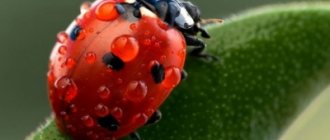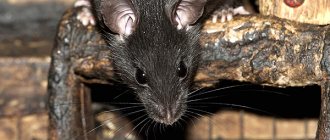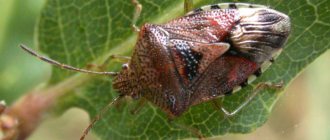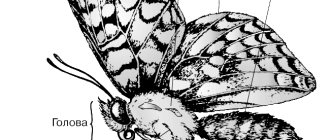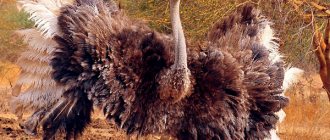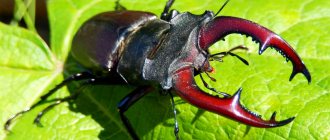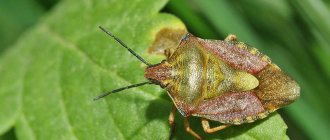Features of black and red varieties of rodents
- Fact:
Rats are very resilient. They adapt to absolutely any conditions. - Fact 2:
In black rats, the tail is much longer than the body, sometimes almost 1.5 times. And in the red species of rats, the tail is an order of magnitude shorter than the length of the body. - Fact 3:
During the year, the female gives birth to three litters, each of which contains up to 20 pups. The rat reaches sexual maturity at three (!) months. - Fact 4:
The red variety of rats is capable of cannibalism.
Man, for his own benefit, created the most complex mechanisms, equipment, devices, built comfortable homes and surrounded him with the most convenient things. But if you return him to natural conditions and leave him on an equal footing with animals in the struggle for survival, then, frankly speaking, it is still unknown who will win.
For example, a rat that constantly lives next to a person, one might say, lives at his expense, is very successful in bypassing the ingenious and tricky traps that people constantly come up with for it. That is, the animal evolves and develops all the time, and who doesn’t know how careful, cunning and resourceful rats are? And no matter how unpleasant it may be to admit this fact, it is true: the rat will always chase people, will always live nearby, will always carry supplies and spoil things. All that remains for a person is to wage a constant and irreconcilable struggle for territory. And something tells me that this struggle will be endless...
Description of the appearance of the rat
There are two varieties of rats, differing in color: black and red. If the red one feels like a mistress all over the planet (well, except for the Arctic and the desert), then the black one prefers warmer and more southerly areas.
- Redhead
The body is up to 25 cm, the fur varies from gray tones to reddish brown (largely depends on nutrition, habitat, temperature). The color on the back is much richer than on the belly. The muzzle is wide, with a short, blunt nose and black round eyes. The ears are also short, and on the inside they are almost devoid of any vegetation.
The gray-pink tail is an order of magnitude shorter than the length of the body. This is one of the main differences between the red type of rat and the black one. The feet are short, pink from the shins to the pads, with separate prehensile toes. The pair of forelimbs is much shorter than the hind limbs, which also have small interdigital membranes. Each finger is equipped with a sharp, strong claw.
- Black
Despite the color definition in the name of the species, it does not always correspond to reality. In addition to graphite, with a gray tint, a black rat can be red or light gray. The belly, like the red one, is much lighter than the back, with a yellowish tint. The size of this species is up to 23 cm. The tail is not just longer than the body, but sometimes almost 1.5 times!
The ears are larger and thinner than those of the red tribesman, and are almost bare on both sides. The eyes are black. The paws in structure and shape do not differ from the red type, with the same strong, sharp claws.
By body type
Purebred rats are differentiated according to many characteristics. First of all, by type, shape and size.
Standard
Animals of this type have a standard physique. They are slender and agile. The tail of the animal is almost the same length as the entire body and head. The eyes are large and shiny, round in shape, and their color is in harmony with the standard coat color.
Small proportional ears are located at the top of the head. The rodent has fur all over its body, it is shiny and fits well. There are short hairs on the paws and tail.
Light-colored animals have short, velvety fur on their ears. They have long, proportional whiskers that are located on their cheeks. There are also antennae above the eyes, but there are much fewer of them and they are much shorter.
Rodents with other types of fur have short, sparse, and curled whiskers. Standard rats are considered the largest among decorative rodents; their weight can reach 500 g.
Dumbo (Mickey Mouse)
Dumbos are distinguished by the structure of the skull and the shape of the ears, which are located not on the top of the head, but below. Due to this, the animal's head looks slightly flattened and expanded. The ears are rounded and widened.
These rats have two types of them - completely open and with slightly bent edges. Among such animals there may be specimens with a slightly protruding nape, although usually it is barely noticeable. The animal's body shape is slightly wider at the back, but the size is smaller than other breeds.
Manx
This species of rat does not have a tail, and therefore is not particularly valued, as it is considered disabled. The fact is that most of these rats have problems with their hind legs and urinary system. These animals have different colors. Their coat can be wavy and curly.
Rat breed – Manx
Lifestyle and reproduction
Rats are very tenacious. They adapt to absolutely any conditions. This is probably why there is no corner on Earth where rats do not live. Except for the Arctic coast and desert droughts. The presence of water is important for animals, so they prefer to settle close to humans. This guarantees both a water supply and an abundance of food.
The fertility of animals is amazing. During the year, the female brings three litters, each of which contains up to 20 pups. The rat reaches sexual maturity at three (!) months.
Black rats feel most at ease in the port areas of the American continents. They are not really allowed to settle on the mainland by their red-haired brothers, who in the struggle for territory have shown themselves to be a stronger opponent. The black rat also does not reproduce as rapidly as the red one. Although the female brings 2-3 litters per year, they are much smaller in number, up to 6 cubs in total.
The red variety is nocturnal. If there is a shortage of food, it can be active during the day.
Features of the red rat:
- He has a sharp mind and very developed intellect. This makes a person’s struggle with it very difficult, often useless.
- Capable of cannibalism. If she has to starve, she is capable of attacking and devouring a fellow tribesman. Some use this feature by taming the animal and making it a “pied rat.”
- Good jumping ability. Capable of jumping up to 70 cm in height and up to 1.5 m in length.
- Very vindictive. Having harbored a grudge, he will definitely take revenge.
- Easily tamed.
Features of the black rat:
- They are nocturnal, becoming active at dusk.
- They are less susceptible to toxic substances, due to which they have high survival rate.
- Not as bold as redheads.
- Less developed intelligence compared to the red one (but still much higher than that of other rodents).
Baby rats
Newborn black rat cubs are characterized by the following:
- complete absence of fur;
- blindness;
- deafness;
- underdevelopment of the limbs.
With all this, kids have an excellent appetite. Every day, the pups noticeably change physically:
- after a week of birth, they start to have fluff;
- after 2 weeks they begin to see and hear;
- after 3 weeks, their skeleton and limbs are fully formed, after which the babies crawl out of the nest.
Month-old baby rats are already absolutely independent - they eat “adult” food, etc. Parents kick their offspring out of their nest, and the grown-up individuals begin an independent life, becoming full-fledged members of the rat colony to which their parents belong. In young females, puberty is completed by six months, after which they are ready to have their own offspring.
Damage from rats to farms
Rats have always brought destruction with their raids, and not a little:
- Destroy any crops at any growth phase. The damage is especially impressive when there is a deficiency of other nutrition.
- Stripping off the bark of trees leads to its death. Entire gardens can be destroyed in this way.
- “What I don’t eat, I’ll render it unusable” is the motto of the rat, which will cover everything that it couldn’t drag away or swallow with excrement and dirt.
- They destroy the nests of poultry, steal eggs, and attack both adult birds and chicks.
- They spoil containers (boxes, bags, nets, etc.), further increasing losses during transportation and storage of products.
Features of rodent teeth
Rat Teeth Rat jaws
are equipped with two types of teeth. Molars are located in the depths of the oral cavity, 3 pieces on each side of the jaw and are intended for grinding food. Flat and wide molars erupt in rat pups on the 19th day of life. First, molars of the first and second types appear, and only on the 40th day do the third ones grow. In front there are 2 pairs of long incisors.
Interesting!
Unlike predators, rats do not have fangs. Their front teeth grow constantly and appear on the 50th day of birth. They are yellow in color. The enamel, located only on the outer surface of the incisors, can be compared in strength to the hardness of steel.
The front teeth need to be constantly ground down, otherwise the rat will not be able to close its mouth. Due to the unevenness of this process, the surface of the cutters acquires a specific shape, reminiscent of a chisel in appearance. The teeth of rats, due to their high strength, allow them to easily overcome any obstacle made of brick, wood, concrete, metal and other materials. When biting, the pressure of the Pasyuk incisors reaches 0.5 t/cm2.
Photos of rats
Here are just a few figures that very roughly convey the damage caused to the economies of some countries by the activities of rats every year:
- Denmark – 10,000,000 crowns.
- USA – $300,000,000.
- UK - £15,000,000.
- India – 750,000,000 rupees.
Nutrition
Black rats are picky eaters. They are wary of unfamiliar products, which makes it difficult to deal with them. A man has to resort to tricks to outwit the swindler and feed him poison for rats.
On a note!
If one of the family is harmed by the new product, the rest of the tailed animals will begin to bypass the bait.
In nature, black rats can eat worms or shellfish. Rodents climb trees and destroy bird nests in search of eggs. In households, the pest causes damage to chicken coops and quail farms. Therefore, any farmer knows how to deal with rats in a chicken coop or poultry house.
The basic diet includes:
- seeds;
- cereals;
- fruits;
- nuts.
The rat does not disdain to feast on the remains of human food if it does not harm its body. The animal eats 15 g of food per day. The black rat does not tolerate a lack of water well. This explains her desire to live in port cities and on ships. The daily fluid intake reaches 20 ml.
The mammal is immune to some rat poisons. The animal cannot be killed by Ratsid or Zinc Phosphide.
Protective measures against rats
- Poisonous, chemical substances.
- Ultrasonic repellent devices.
- Pied Cats.
- Mechanical traps, traps.
- Breeding birds of prey.
- Preventive maintenance for cleaning garbage cans and heaps.
- Raising a rat catcher from the rat itself.
- Services of companies involved in pest control.
The fight against rats must be merciless, until complete victory. Do not forget that the rodent is also a carrier of the most dangerous, deadly diseases: plague, rabies, leptospirosis, etc.
By coat color
Decorative rats are also conventionally divided into several groups according to the type and color of their coat.
Homogeneous (Self)
Rodents of this species have absolutely the same coloring throughout their entire body. Rats are black, white, blue (color with a silver tint. Russian blue and smoky blue are also found. They are very similar in color, the former have a dark color and a light belly, and the latter have a more pronounced blue tint.
Rats in gray-brown tones with a silver-bluish tint with cherry eyes are called mink. There is also an American mink species, these animals have a darker eye shade.
Light gray color with a cool blue tint. The eyes are black or dark red. This is a platinum shade.
Blue, platinum rat
The beige color of the rats resembles coffee with milk. And completely white animals with red eyes are usually called albinos.
Very beautiful coloring of rats - champagne. This species of animal has a light, slightly pinkish color. The eyes are pink.
Russian silver is an interesting light gray color with a blue tint. This variety is characterized by fuzzy ripples of color.
The main color of the “dav” species is pale gray with a pinkish tint. It has a characteristic light ripple. Rat "Lilak" - light ash color, slightly mixed with chestnut color. Eyes black or dark cherry.
Officially unrecognized colors of domestic rats:
Ticked colors
They are distinguished by uneven coloring of the hairs, that is, there are places on them that may have pigments of different colors.
Agouti
This coloring is characterized by a beautiful chestnut color. Some hairs are black. Short and medium hairs have bands. They must be free of orange and yellow, and it is better if they are of the lightest shades.
The base color consists of a dark gray or light brown tint. The ends of the hairs are black and the belly is silver-gray.
Rat – Agouti
There is also a blue agouti - the belt of hairs can be red and brown, and the belly is light gray-blue with inclusions of silver hairs.
They multiply at an incredible rate
Another type of movie monster is distinguished by the fact that it breeds a population of its own kind at an incredible speed. Usually these are alien creatures who intend to fill the entire Earth with themselves in record time. They may appear as shapeless amoebas made of flesh and teeth that reproduce by division, or as hideous winged monsters that lay eggs in human bodies. One thing is constant - they all multiply very quickly.
This group includes James Cameron's Aliens, John Carpenter's The Thing and... that's right, our rats.
One pair of rodents manages to give birth to up to 6,000 cubs in 2–3 years of their life. Less than three months pass before new offspring also begin to reproduce, and so on. Moreover, it is not customary for them for the younger generation to go to seek a better life in foreign lands. If there is enough food, they will not move until they flood the whole city.
By the way, many regions that skimped on pest control during the recession experienced a real rat outbreak. Britain's rat population now stands at around 80 million, up 200 percent from 2007. And even with all modern methods of rodent control, in New York there is at least one rat per person.
Who is most susceptible to attacks?
Rats are smart and even smart animals (it’s not for nothing that they manage to survive in the most unfavorable conditions), so most often they attack those they consider weak prey. And therefore, children, old people, sick and weakened people suffer more. In addition, prisoners often become victims of rats (there are a lot of rats in prisons, and they often try to take food from prisoners), homeless people living in rat habitats and disturbing them, as well as alcoholics.
Rats do not attack people often, but such cases do occur.
Sources
- https://krot911.ru/krysy/o-krysax/napadayut-li-krysy-na-lyudej.html
- https://eparazit.ru/mozhet-li-krysa-napast-na-cheloveka.html
- https://apest.ru/krysy/vse-o-krysah/chem-opasny-krysy-dlya-cheloveka/
- https://petse.ru/gryizun/myish_krys/napadayut-li-krysy-na-lyudej.html
[collapse]
Spreading
Previously, the black rat lived only in North Africa and the subtropical zones of Eurasia. With the help of humans, the rodent has spread throughout the world. Now the habitat of the animal is shrinking. But in regions with a warm climate, the animal continues to actively reproduce.
The spread of the pest occurs in the following ways:
- Through goods transported by people by land, water and air.
- Independently along roads and railways.
Tiny paws run several kilometers a day. The rat quickly finds a comfortable place to live and acquires a flock.
Man's old "friend"
The homeland of the black rat is considered to be East and Southeast Asia, from Vietnam to Afghanistan. It appeared in the Mediterranean and the Middle East back in the Pleistocene era, when mammoths trampled the icy tundra of Yakutia, and Neanderthals ruled the territory of modern Spain, Greece and Italy.
This species was the first to begin to inhabit human housing even when the housing itself was simple huts and caves. And as cities developed, rats became more and more “civilized.”
It was black rats that caused the first outbreaks of the plague pandemic in Europe. In nature, settlements of this species are natural reservoirs of the plague pathogen, from here the animals easily carry plague bacilli into cities. Humans are directly infected with the plague by fleas that have previously bitten sick rats.
In general, the most devastating plague pandemics in medieval Europe arose after the invasion of the Pasyuks. However, the townspeople at that time did not particularly distinguish between these two species, and therefore the more familiar black rats for a long time (if not forever) became a symbol of death, unsanitary conditions and “dark” times.
Before the appearance of pasyuks, black rats were the main pests of agricultural supplies throughout Europe and Asia. In German cities, bonuses were given for the destruction of a large number of these pests; there were even days of prayer for getting rid of rodents.
These measures, however, helped little, and even today, being armed with the most effective poisons and ingenious devices, people only manage to keep the number of rats within certain limits with great difficulty. Much more effectively than all poisons and traps, the black rat is suppressed by its closest relative, the pasyuk.
Lifestyle
Life of rodents
The black rat becomes active at night. A person determines the presence of a pest in a home by rustling, rat squeaking and scratching sounds.
The lifespan of a rat depends on its habitat:
- in nature, pests live 1-2 years;
- in captivity the animal can live up to four years.
Rodents do not gather in large flocks. They prefer to live in small groups - five to seven individuals. Each clan has a hierarchy. The group includes:
- dominant;
- subdominant;
- subordinate male.
Mammals are able to live in any corner. They build nests in the ceilings of houses, elevator shafts, and attics. The animals drive away individuals that do not belong to the pack from their territory.
Interesting!
People have found rats in freezers. There, rodents built nests from animal tendons.
Black rats are not as aggressive as pasyuki, which fight within the group. When in danger, these rats can even attack humans. The black species prefers to escape. But if he is caught or cornered, he will try to defend himself and attack.
They're thirsty for your blood
We have reached the last, one of the most disgusting types of monsters, which have only one goal - to drink your blood. All sorts of zombies, vampires, werewolves and even “Jaws” are the most motivated monsters presented in our article. Because they think you're delicious.
And here rats are no exception. Everyone knows that rats are not averse to carrion. And it is also believed that they are completely indiscriminate in food. But it is not so. There is something they have a particular weakness for - human blood. And if a rat tastes this “delicacy” once, it will not calm down until it gets to it again.
Scientists who have been studying rats for 22 years say your best chance of getting bitten by a rat is between midnight and 8 a.m., while you're sleeping peacefully in your bed, unaware that the infectious critter is about to grab your face. And this is not an exaggeration either: rats most often bite the face or hands.
And these are not spiders that will bite once and that’s it. If a rat has bitten you once, there is a really good chance that it will want to continue the banquet.
And she bites not necessarily for the sake of self-defense or out of fear, and not even because she is hungry.
She just wants your blood. Literally. In 1945, Professor K. Richter conducted a study whose purpose was to find out what attracts rats to people. He gave the rats access to large quantities of human blood. In 24 hours, the rodents drank every drop - and this was four times their usual daily amount of food! Here is Richter's conclusion, word for word: "Rats may actually develop a strong affinity for fresh human blood."

